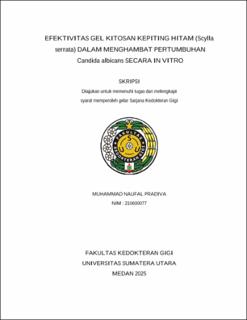| dc.description.abstract | Chitosan is a polymer biomaterial obtained through the deacetylation of chitin and is widely utilized in various processed products. One invertebrate species with a hard shell that contains a significant amount of chitin is the black crab (Scylla serrata), with approximately 70% chitin content compared to other crustaceans and around 20-30% of its dry shell weight. Chitosan has been shown to inhibit Candida albicans, a fungus involved in the development of dental caries. Candida albicans contributes to the adhesion mechanism of Streptococcus mutans bacteria on teeth, facilitating the occurrence of caries. This microbe is considered part of the normal flora of the oral cavity, residing on the surface of the mucous membrane in a balanced coexistence with other oral flora. Infections caused by Candida albicans can range from superficial conditions such as oral candidiasis and vaginal candidiasis to severe systemic infections, particularly in immunocompromised individuals. This study aimed to evaluate the effectiveness of black crab (Scylla serrata) chitosan gel in inhibiting the growth of Candida albicans. The research employed a laboratory experimental design with a post-test only control group design, using Candida albicans ATCC 10231 as the test sample. The study utilized black crab chitosan gel at concentrations of 0.5%, 1%, 1.5%, 2%, and 2.5%. The positive control group was treated with 2% ketoconazole gel, while the negative control group was treated with a placebo gel made of CMC-Na. The inhibition of Candida albicans was assessed by measuring the inhibition zones around paper disks. The diameter of the inhibition zones (in millimeters) was recorded for each chitosan gel concentration as well as for the negative and positive controls. Data analysis was performed using the One-way ANOVA statistical test. The normality of the data in all groups was first analyzed using the Shapiro-Wilk test, while homogeneity was evaluated using Levene's Test. The results indicated that black crab (Scylla serrata) chitosan gel demonstrated inhibitory effects against Candida albicans. However, the 0.5% concentration of the chitosan gel showed no inhibitory effect on Candida albicans. In contrast, the chitosan gel concentrations of 1%, 1.5%, 2%, and 2.5% exhibited inhibitory effects. The positive control group demonstrated greater efficacy in inhibiting Candida albicans compared to chitosan gel at concentrations of 1%, 1.5%, 2%, and 2.5%. | en_US |


